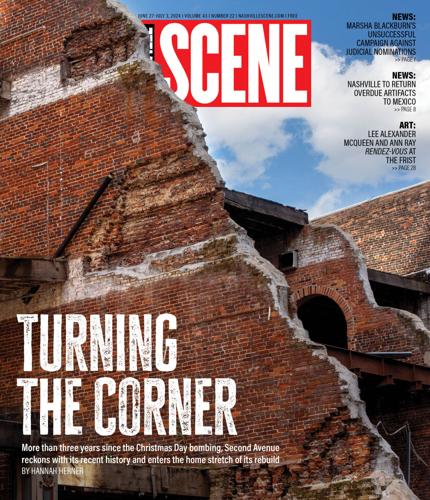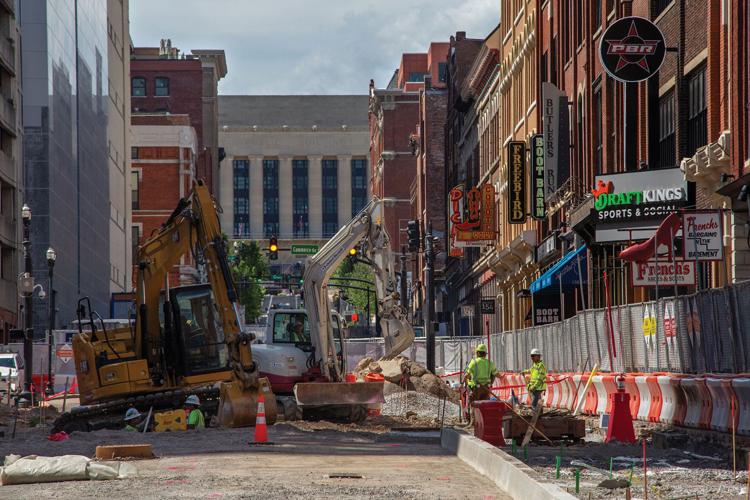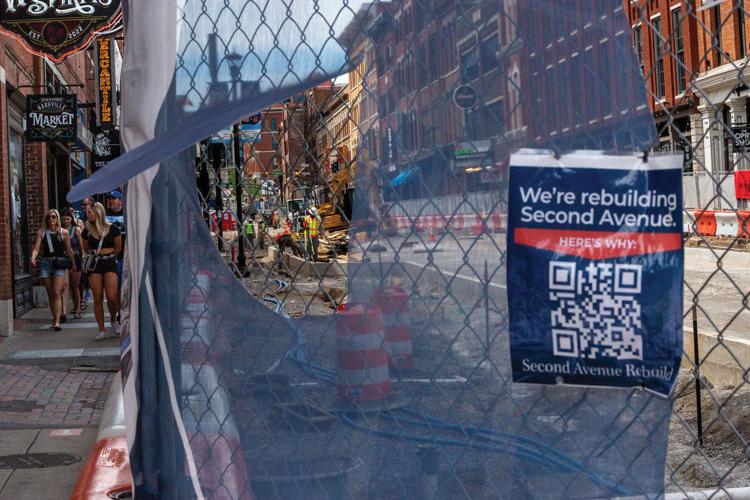Photos and additional reporting by Hamilton Matthew Masters
Three singed Laser Quest passes are encased in cellophane envelopes in the archives at the Tennessee State Museum. The youth-group favorite — whose downtown location closed in September 2020, citing economic troubles during the pandemic — is part of many longtime Nashvillians’ personal history. It became part of the state’s history, too.
The passes are among the few artifacts collected to represent what took place on Second Avenue on a pivotal day: Dec. 25, 2020, when a 63-year-old Antioch man parked his RV on the street, sent out an eerie warning via a PA and detonated a bomb. He and his dog were the only fatalities due to the blast, but Second Avenue’s streetscape was left critically injured.
Out of 46 street-level storefronts on Second Avenue North, 25 closed their doors in the months after the bombing. Those still standing have survived a bomb, a pandemic and construction that severely impedes foot traffic, but they have one more hurdle to clear before seeing the new Second Avenue: the latest round of construction.

View of Second Avenue the morning of the explosion
Three-and-a-half years after the Christmas Day bombing, the street is still in various levels of disarray. Earlier this year, the northernmost block in the three-block stretch between Commerce Street and Union Street opened to cars. The south block, closest to Broadway, is set to be completed at the end of the year, with the most visibly destroyed middle block slated for completion by the end of 2025.
Due to the pandemic, the bombing or construction — or possibly some combination of the three — Second Avenue lost B.B. King’s, one of the few places that centered Black artists downtown. Gone are some local special-occasion dinner favorites, like Rodizio Grill, The Melting Pot and The Old Spaghetti Factory. A small petition to bring back Hooters has circulated, and downtown employees say they miss Sbarro. The city’s only hostel hasn’t been able to get back on its feet yet either. Simply the Best $10 Boutique had to move across town, while Doc Holliday’s Saloon, Dick’s Last Resort and Coyote Ugly bounced back. Sweet shops Mike’s Ice Cream, Mattheessen’s and Leon’s Candy are holding strong. The giant shoes outside French’s Shoes and Boots were unscathed by the bombing and have since been joined by Freebird and a new, more upscale Boot Barn. Nashville Live! took the place of The George Jones, and after 25 years, Wildhorse Saloon will be replaced by Luke Combs’ Category 10.
Mayor Freddie O’Connell has a history with the area as the former Metro coucilmember representing the district.
“On Christmas Day 2020, part of the fabric of not just Second Avenue but the city was torn by a devastating bombing,” O’Connell tells the Scene. “Though there was no further loss of life, anyone visiting Second Avenue today still sees the scars, years later. Despite a tragic blow to a quirky, historic stretch of our downtown, we’re intent on building back better.”
When the bombing happened, the Federal Bureau of Investigation and Tennessee Bureau of Investigation surveyed the area as a crime scene. That means historic concerns had to be put aside, and artifacts were taken for evidence. It wasn’t until mid-2022 that the Tennessee State Museum received its first artifacts, given over by investigators via the Metro Historical Commission.
There’s a crumpled metal sign denoting a 5G area — 5G being one of the bomber’s conspiracy theory-powered motives. Another damaged paper sign shows masking instructions, firmly placing the event during the height of the pandemic. A decorative guitar with the back blown off is very Music City. A note scrawled with “fantastic birthday dessert!” which curators suspect is from The Old Spaghetti Factory or The Melting Pot, is a relatable human touch.
The artifacts may not look especially significant, head curator Richard White tells the Scene — but there’s a way to interpret each one that tells a story of that day.
“We do look at events like this and think, ‘Is this significant enough to add to the collection — to be able to tell that story in 50, 100, 150 years?’” White says. “This, we thought, was enough because it rose to the level of national news, and it affected a large part of the historic district in Nashville for several years.”
Nashville is just beginning to explore how to remember the bombing. The Metro Historical Commission recently installed a small exhibit in its lobby: a couple of columns broken cleanly in half, demonstrating the power of the blast. The state museum may add a display about the bombing as part of a revamp of its modern history section in the next few years. But museum staff is dependent on what the public brings them, and White says curators are hesitant to ask anyone to donate their personal belongings to the museum.
The final result will be nuanced, and not focused on the bomber himself.
“It would be more reflective and contemplative on what it meant for Nashville, what it meant for the people that were in that neighborhood,” White says. “Part of the interpretation with this someday could be something as simple as, ‘This could have been so much worse.’”
Betsy Williams — a longtime Second Avenue resident who some folks refer to as “the mayor of Second Avenue” — says she was the first to call 911 on Christmas Day 2020. She was evacuated from the Rhea building, where she lived and owned short-term rental properties. (The building was also home to Rodizio Grill and The Melting Pot.)
“People have forgotten a lot about the bomb, because we’ve had a lot of other issues that have come up,” Williams says. “Tornadoes and all of the weather stuff, and just the explosive growth of downtown, and the need for transit — there’s just been other things that have come up that have sort of removed this from the forefront of people’s thoughts. That’s understandable. We need to keep it to the front because it’s an expensive project, and it’s an important project culturally and historically for Nashville.”
The Rhea building, which Williams’ brother owns, is still undergoing mediation with its insurance company, so she declines to comment on future plans.
The most work is left to be done on that middle block — the one between Church and Commerce. That’s where the buildings, including the Rhea (164-168 Second Ave. N.), still look like a chunk was bitten out of them. So far the AT&T network equipment building has a fresh shell, decorated with a piece by Nashville artist Phil Ponder. A keen eye can still spot a depression in the ground near the building — that’s where the RV was parked.
The Callan family, which owns four buildings with addresses of 170 through 176 Second Ave. N., tells the Scene through a lawyer that the family is set to unveil a developer for the sites soon, with plans already approved by the Metro Historic Zoning Commission. The family put the buildings up for sale in November, and had collected all available insurance payments at the time. The lawyer says the family spent a mint to stabilize the buildings so they wouldn’t collapse completely following the bomb, and didn’t have enough remaining money to continue repairs.

Second Avenue, July 1994
The Metro Council recently shot down an effort to revitalize the former Old Spaghetti Factory space at 160 Second Ave. N. A developer wanted to open it as mixed-use space again, with a restaurant on the ground floor and 62 short-term rental units on the upper floors. Metro Councilmember Jacob Kupin — whose District 19 contains the area — is not necessarily pro-short-term rentals, but he tells the Scene it’s a challenge to find willing developers for the area. Affordable housing is hard to make profitable, and with the added layer of needing to abide by historic preservation guidelines, developers may choose a path of less resistance.
“It’s a tough building to make work financially,” Kupin says.
He believes the vote down was on a technicality — because short-term rentals within 100 feet of a park (in this case, Riverfront Park) need council approval. He argues that approving more short-term rentals in the downtown core could mean fewer in residential areas, with the added benefit of some money going back to the city from short-term-rental taxes.
“If there’s anywhere to draw an exception, I would think a building that was destroyed by a bomb on the street that was greatly negatively impacted by a pandemic that is currently desperately seeking redevelopment — to me seems like an area where we can safely do that,” Kupin says.
Bombing and pandemic aside, construction has been a challenge for Second Avenue businesses, as would-be patrons simply don’t think they’re open. Employees at French’s tell the Scene that sales were back up to pre-pandemic levels until the construction on the road in front of the store kicked in at the beginning of the year.
It’s one thing after another, says Crissy Cassetty, director of economic development with the Nashville Downtown Partnership. She points out that construction for Chief’s on Broadway, which began in 2022 and wrapped in April, blocked the sidewalk and added insult to injury for Second Avenue.
“[Patrons] would be coming down Broadway, they would see the big barricades right there [outside Chief’s], and they would turn around,” Cassetty says. “No one was turning down Second Avenue.”
Since the beginning of the year, Cassetty has heard from businesses that sales are down as much as 65 percent because of new construction on the road. That’s why the Downtown Partnership in April introduced the Turn the Corner Campaign, which is responsible for the hot-pink signage in the area. With the help of communications firm McNeely, Pigott and Fox, the organization also launched a website highlighting businesses on the avenue — 70 percent of which are locally owned, Cassetty says.

A QR code posted by MDHA
Until the bombing, Second Avenue saw an average of 27 percent of Broadway patrons turn the corner, according to numbers collected by Nashville Downtown Partnership. Post-bombing, that number dropped to 20 percent. After construction started and the barricades went up, it dropped to 12 percent. In most recent numbers, it’s back up to 16 percent of foot traffic spilling over to Second Avenue from Broadway.
Construction was completed between Church Street and Union Street, also known as the north block, on June 3. Breaking up the construction block by block speeds up the process and minimizes interruption to businesses, says Michelle Scopel, urban development senior project manager for the Metropolitan Development and Housing Agency.
The north block is mostly home to office buildings, but patrons can see a preview of what’s to come: wider sidewalks, ample crosswalks and street lights approved by nonprofit DarkSky (meaning they won’t affect birds’ migratory patterns) — but also planters that are specifically designed to deter unhoused Nashvillians from sitting or sleeping on them. Street parking will be eliminated, too.
The south block will leave room for street dining and permanent kiosks for food and shopping — think Bryant Park in New York City. When the crosswalks come back and they look like pianos, that will be thanks to Williams’ urging.
“We’re excited to finally have something to celebrate on Second Avenue,” says Scopel. “It’s been a long time coming.”
There are two main reasons that Second Avenue currently looks the way it does, according to stakeholders. Insurance is one reason — people like Williams and the Callans are still duking it out with insurance agencies, or finding it hard to secure enough funds after the insurance payouts run out. The second reason is that the bomb damaged underground utilities.
Scopel says the underground work has been surgical in nature. Working with antique pipes, her construction team carefully dug through 10 to 11 feet of bedrock, not knowing what they would uncover. They separated the combined sewer system, routing storm water to the Cumberland River and sewage to the sewer. That helps with odors too, so the outdoor dining vision can succeed.
“I think that they’ve moved at the speed of light, when you think about the upper third of the street already being open, and another third in six more months, and the other third open by the end of 2025,” Williams says. “That’s significant movement for a project of this magnitude.”
With Second Avenue being forced to start from scratch, longtime downtown-centric nonprofit The District is taking the opportunity to start a trash pilot program. MDHA and The District want to see First Avenue (now the back door of Second Avenue) cleared of trash so it can also host outdoor dining and more foot traffic as the land surrounding it is developed.
More upscale, less rowdy, more locals — that’s the repeated refrain from those involved with Second Avenue.
“The whole goal is to elevate the experience and give something different than Broadway,” Scopel says. “Because Broadway is awesome, and does a great service for our city, and I think it’s wonderful, but there’s no reprieve.”
“I appreciate Nashvillians’ patience as we work to open the last blocks of the street,” says Mayor O’Connell. “I fully expect that the wait will be worth it.”
In the meantime, businesses in the area need help to make it across the finish line.
“People need to go down there and support our businesses in order to help get them through this so that when the project is finished, they’ll still be there,” Williams says.
It wasn’t that long ago that The District’s fund, Second Avenue Strong, was hosting a telethon at Wildhorse Saloon. They showed a video of scenes from the bombing. It was still raw for Williams. And in some ways, what happened on Second Avenue is still raw for many Nashvillians.
“I surprised myself so much because I just sat there and burst into tears,” Williams says of the moment. “I had no idea that I was going to have that kind of reaction. It was significant for the people who lived on that street, for us that had businesses. It was so disruptive to everything down there, clearly. We were just going, ‘What are we going to do?’ We’re still doing that.”









